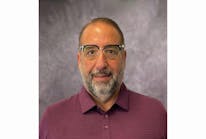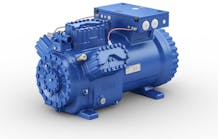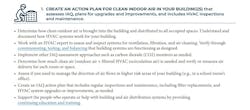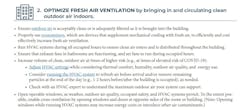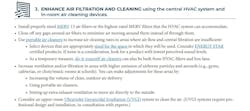By ROB McMANAMY
In March, the Biden Administration released its National COVID-19 Preparedness Plan, “a roadmap to move the country forward safely” and to return normalcy to daily life in the U.S. while continuing to combat the pandemic. A key component of the plan is the Clean Air in Buildings Challenge, which calls on all building owners and operators, K-16 schools, and organizations of all kinds to adopt strategies to improve indoor air quality (IAQ).
“This is a really big deal,” said Dr. William Bahnfleth, P.E., chair of the ASHRAE Epidemic Task Force, and professor of architectural engineering at Penn State University. Speaking to The New York Times on March 28, he added, “It’s making the start that is often the most difficult part.”
So far, that start is taking the form of a best practices guide published by the Environmental Protection Agency (EPA) and available here. Developed in collaboration with the U.S. Dept. of Energy, CDC, and other federal agencies, the guide offers a set of clear recommendations with a menu of actions for building owners to implement. Under the American Rescue Plan, signed into law last year, nearly $500 billion in federal funds can be used in schools, public buildings, and other settings to improve IAQ.
“The Challenge is an important part of helping us all to breathe easier,” said EPA Administrator Michael S. Regan in announcing the launch. “Throughout the pandemic, building managers and facility staff have been on the frontlines implementing approaches to protect and improve indoor air quality to reduce risks and keep their occupants safe and healthy.”
Now, they are eligible to receive hard-earned federal support for ventilation and filtration upgrades.
It marks “an unprecedented opportunity to increase awareness and build momentum for transforming the places where we spend 90% of our time,” said Rachel Hodgdon, CEO of the International WELL Building Institute (IWBI). “We are excited to work in coordination with EPA and other government leaders, as well as across our community, to provide education, training and tools for optimizing indoor air quality... As we’ve said since the onset of the pandemic, our buildings, and those who operate them, can be deployed as frontline caregivers to mitigate the spread of COVID-19.”
Funding within the State and Local Fiscal Recovery Fund program and the Elementary and Secondary School Education Relief program can be spent on inspection, testing, and maintenance of current ventilation systems; purchasing portable air filtration units, with HEPA air filters; purchasing MERV-13 (or higher) filters for HVAC systems and air conditioners; purchasing fans; repairing windows and/or doors; servicing, upgrading, or replacing HVAC systems consistent with industry standards, and more.
"There are encouraging signs that indoor air quality is becoming far more mainstream, particularly as the world slowly emerges from the shadows of the pandemic," wrote Forbes sustainability columnist Jamie Hailstone in April.
“IAQ has become a national priority,” added Ray Wu, CEO of Wynd Technologies Inc., a maker of portable air cleaners. Writing in Commercial Observer, he said the Challenge is “federal acknowledgement of a major shift that’s shaking up the health, real estate and building management sectors.”
But that shift is also an overdue next step, said Dr. Alondra Nelson, Deputy Director, White House Office of Science and Technology Policy (OSTP). “For decades, Americans have demanded that clean water flow from our taps and pollution limits be placed on our smokestacks and tailpipes. It is time for healthy and clean indoor air to also become an expectation for us all,” she wrote on the OSTP blog in March.
"Despite its importance, poor ventilation has been a widespread and persistent problem in buildings for decades," added the International Association of Sheet Metal, Air, Rail and Transportation Workers (SMART) in its own statement. "Proper ventilation is not only a key to our recovery, but it will also help cut building emissions, lower energy costs, ensure systems are meeting design intent and make buildings safe for occupants."
On May 9, Rep. Don Beyer (D-VA), who chairs Congress’ Joint Economic Committee, introduced the new Airborne Act, related legislation that would incentivize nonresidential building owners to conduct IAQ assessments and upgrade their ventilation and air filtration systems. The bill introduction followed a sharp uptick in workers returning to in-person work in April, according to the Bureau of Labor Statistics.
“Improving indoor air quality reduces the risk of COVID-19 transmission, but it also can benefit employers and workers by reducing sick days, creating a cleaner and more comfortable work environment, and lessening the risk of long-term health conditions,” said Rep. Beyer. “The COVID-19 pandemic has illustrated the dangers of airborne respiratory diseases and the importance of adequate indoor ventilation and indoor air quality, but the improved HVAC and air filtration systems necessary to improve air quality can be expensive to install and maintain. Our bill would use the tax code to give building owners incentives to perform IAQ inspections and upgrades, which would make our make workplaces safer from both the threat of Covid and future airborne disease outbreaks.”
ASHRAE served as a technical advisor on the drafting of the legislation, which still needs to be voted upon in the House of Representatives.
Of course, many well-meaning government programs fail to live up to their expectations. So why do so many now view the new EPA Challenge as "a big deal"? We asked Dr. Bahnfleth that very question. Here is his response:
It has been a problem throughout the pandemic that there has been something of a national leadership vacuum in the U.S. where engineering controls – indoor air quality measures – to mitigate risk are concerned. For a long time, the White House did not have anything to say about the importance of indoor environments in transmission of Covid and government guidance on ventilation, filtration and air cleaning came from a variety of sources and agencies that were not always on the same page. Now that it does, change seems more within reach.
The White House program, while not backed up by significant new resources yet, does a lot to raise awareness of the importance of indoor air quality both in responding to Covid and beyond. I think it can help open a discussion about the need for a national code basis standard for indoor air quality (e.g., ASHRAE Standards 62.1 and 62.2) analogous to the situation with respect to energy use of buildings. Even if voluntary, I believe it would have a beneficial impact on the way buildings are designed and operated. In addition, there would be motivation for standards to increase in stringency over time to protect the health and well-being of building occupants that doesn’t exist currently.
##########
Below, the four prongs of the new EPA best practices guide...
For additional resources and to access the links above, click here.
##########


